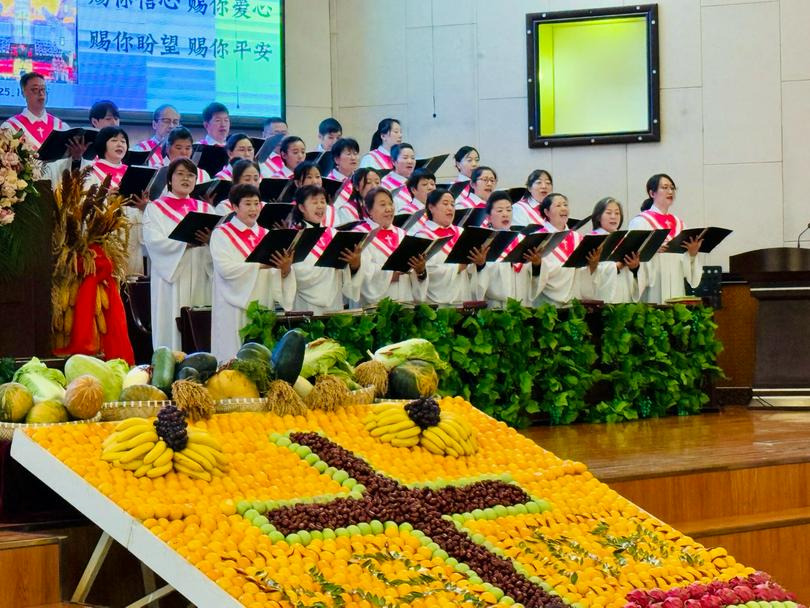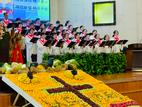"In the clear, refreshing air of autumn's golden days, farmers reap the fields, wildflowers bloom, and fruit bends the branches. The land gleams with gold and the rivers with silver. Grace poured out by our Heavenly Father upon you and me..."
As the melody played, several Christian women wearing blue headscarves and aprons lifted winnowing baskets, rhythmically reenacting scenes of the autumn harvest. This performance was part of a recent Autumn Harvest Thanksgiving celebration at a church in Northeast China.
In this region, where the four seasons are distinct, autumn marks both the busiest harvest period and one of the most significant festivals for many churches—the Autumn Harvest Thanksgiving.
Spanning from the ripening rice fields of October to the colder days of November, the festival has no fixed date. Each church sets its own celebration according to the needs of its congregation, resulting in different churches within the same city observing the festival on various weekends.
Preparation begins a month in advance, with church members carving out time from their busy routines. Different types of agricultural products, handmade models, and farm tools may become props for the performances on this day.
One of the most popular performances featured two brothers carrying shoulder poles as they shouted lively slogans. Dressed as farmers, they walked around the stage with loads of corn, chili peppers, cabbage, and green onions, calling out, "Brothers, come on. Use your strength, carry it up, and go to the sanctuary to worship God!"
Small handcarts piled with various fruits and vegetables were also pushed and pulled across the stage, vividly portraying a scene of abundant harvest. As they moved, participants sang, "Across China's land, the five grains will surely flourish; this year the harvest will be doubled, doubled…" The faces of all believers shone with joy and contentment.
On the pulpit, believers displayed harvest offerings brought from their homes, including golden corn, giant winter melons, and strings of chili peppers. Some were arranged in the shape of a cross, others spelling out "Immanuel."
On this day, numerous sermons focus on gratitude, reminding believers that Christians should not give thanks only on Thanksgiving but should cultivate a continual spirit of thankfulness. Gratitude is a response to God's love. For many believers, the most direct expression of gratitude is financial giving. Some preachers note, however, that true offering goes beyond material contributions, which is the dedication of one's entire life, including emotions, time, talents, and aspirations, as a wholehearted commitment to God.
The original purpose of Autumn Harvest Thanksgiving is to remember God's blessings. Yet amid the bustle of various celebrations, a question repeatedly surfaced in my mind: In the midst of such lively gatherings, are the lives of the church and its believers as fruitful as the harvest on display? Behind the joyful scenes, is the church also experiencing a rich spiritual harvest among its members? Or is the flock at risk due to insufficient pastoral care?
In City M, several large churches see an attendance of one to two thousand. At one church, both the chapel and the auxiliary hall were filled with worshippers on this year's Harvest Thanksgiving Day. The morning featured a series of commemorative events, including baptisms, honoring the elderly, Autumn Harvest Thanksgiving celebrations, and weddings.
A sharp warning at the main hall entrance caught many by surprise: "Nearly a hundred heretics visit the church each week to recruit members," reminding believers not to share their contact information with strangers.
Despite this, some attendees were still approached. One believer mentioned overhearing a conversation in the restroom: "How did you enjoy the service today?" followed by, "I usually study online more; do you want to join?"
When pastoral care is limited by pulpit capacity, a large congregation, and an inflexible pastoral structure, gaps emerge that heretical groups can exploit. This church offers only two Sunday services, each lasting an hour, which can feel more like a brief "stopover" for nearly two thousand members. In light of such interference, questions arise: what preventative measures can the church take, and how can it protect its flock? These are issues church leaders must address with careful consideration.
In the same city, another church with 500 members also faces challenges, including an aging congregation and infiltration by cults and heresies, yet its pastoral management practices are impressive.
Upon entering, visitors are guided to register at the entrance, clearly distinguishing newcomers from long-time members. This allows church leaders to quickly grasp each visitor's basic information.
The church employs a small-group pastoral care system. After weekday worship services, members gather in small groups organized by different areas. Each participant receives a name tag displayed at their assigned seat, making attendance visible. While this system does not track every member, it ensures that participants attend at least once a month and are committed to the small-group structure.
A ministry worker explained that this threshold is not meant to exclude anyone but to ensure believers are willing to be spiritually nurtured so that when they are absent, leaders can genuinely care for and pray for them.
Ultimately, differences in pastoral care and management highlight a key question: Who guides the church, and who determines the direction of its pastoral care?
In many churches in City M, the issue of "family succession" is unavoidable.
The notion that "a pastor's child should also become a pastor," a practice not rooted in Scripture but regarded as traditional, deeply influences some congregations. As a result, leadership succession often seems natural, with little question.
In one church, the previous leader was an elderly deacon. After his retirement, his daughter, now in her seventies, assumed the role of elder. While nominally a continuation of service, in practice, it was a family succession. The church also has two pastors, one of whom served for nearly 30 years, from youth to middle age, yet never held meaningful decision-making power. He candidly admitted that, despite differences in pastoral philosophy, he was powerless to effect change.
"I now focus only on my pulpit work and delivering each sermon well; I cannot decide anything else," he said. "Sometimes I wonder if I've become part of the silent majority." His words reveal a profound weariness, the fatigue of wanting to serve yet being unable, of seeing problems but being unable to speak the truth.
This raises an inevitable reflection: when spiritual authority becomes family power, and leadership succession follows bloodlines rather than calling, where will pastoral care ultimately lead the church?
On the pulpit during Autumn Harvest Thanksgiving, fruit can easily be piled high, but spiritual fruit requires pastors' effort. True harvest is not measured by the season, but by the life it nurtures.
(The names of the churches are not disclosed, and "City M" is used as a pseudonym for safety reasons.)
Originally published by the Gospel Times
- Translated by Poppy Chan












